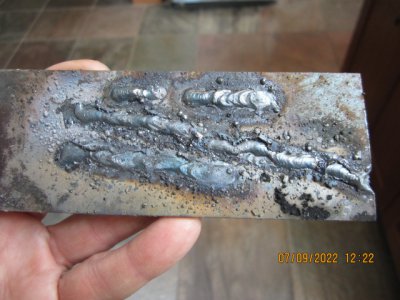- Joined
- Jul 28, 2017
- Messages
- 2,386
I recently bought a cheap inverter stick welder from Amazon to play with. I never have used one prior to this so wasn't sure how difficult it would be to use. The photo below shows my very first attempts at using a stick welder:

My first "bead" is on the bottom. The arc length clearly was far to long. I used 2mm 6013 rod. The first try was at 80 amps and that was WAY too much current. It ate up that rod like nobody's business. The center bead was done at 70 amps. Better. The top two short beads were done at 60 amps. Better yet and might actually be useful for making something . I also was learning some technique along the way so I probably now can get 70 amps to look better, too.
. I also was learning some technique along the way so I probably now can get 70 amps to look better, too.
Based on my initial trials, the 2mm rod seems pretty small for most jobs I'd be doing. I need to get some larger-diameter rod and see how that works. According to the manufacturer the welder can go up to 200 amps so there's a lot of headroom to play with.
I'm not going to be using the welder to make stuff like trailers where the failure of a weld could spell catastrophy. It mostly will be for repairing gardening tools, making workbenches.and the like.
The slag is pretty tough, took a bit of chipping to get it off.
This type of welder basically is a type of heavy-duty switching mode power supply. SMPS'es don't seem to be as reliable as the old linear PSU's but with one of those you're not going to be getting 200 amp capability in a box you can (easily) lift with one hand.

My first "bead" is on the bottom. The arc length clearly was far to long. I used 2mm 6013 rod. The first try was at 80 amps and that was WAY too much current. It ate up that rod like nobody's business. The center bead was done at 70 amps. Better. The top two short beads were done at 60 amps. Better yet and might actually be useful for making something
Based on my initial trials, the 2mm rod seems pretty small for most jobs I'd be doing. I need to get some larger-diameter rod and see how that works. According to the manufacturer the welder can go up to 200 amps so there's a lot of headroom to play with.
I'm not going to be using the welder to make stuff like trailers where the failure of a weld could spell catastrophy. It mostly will be for repairing gardening tools, making workbenches.and the like.
The slag is pretty tough, took a bit of chipping to get it off.
This type of welder basically is a type of heavy-duty switching mode power supply. SMPS'es don't seem to be as reliable as the old linear PSU's but with one of those you're not going to be getting 200 amp capability in a box you can (easily) lift with one hand.


